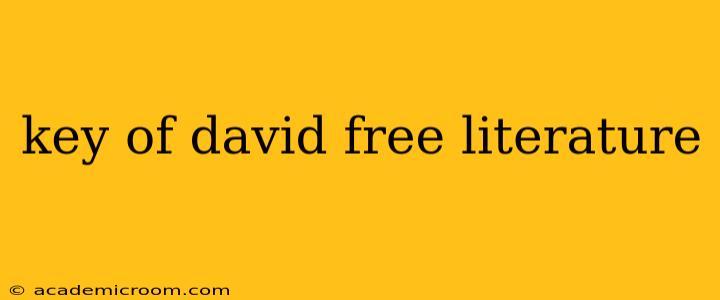The "Key of David" is a fascinating and multifaceted symbol that appears throughout religious texts, esoteric traditions, and even secular literature. While often associated with biblical prophecy and spiritual unlocking, its interpretation varies wildly depending on the context. This exploration delves into the diverse representations of the Key of David in freely available literature, examining its symbolic power and exploring different interpretations.
What is the Key of David in the Bible?
The biblical reference to the "Key of David" (Isaiah 22:22; Revelation 3:7) generally symbolizes authority and dominion. In Isaiah, it represents Eliakim's appointment as steward over the house of David, signifying his entrusted responsibility. In Revelation, it's associated with Christ's power to open doors that no one can shut and shut doors that no one can open—a metaphor for his ultimate authority and access to all things. This foundational biblical meaning provides a springboard for the diverse interpretations found in subsequent literature.
What does the Key of David symbolize in different literary works?
The Key of David’s symbolism often transcends its strict biblical interpretation, becoming a powerful motif employed by authors to represent various concepts. It can symbolize:
- Knowledge and Understanding: The key can represent access to hidden knowledge, secret truths, or spiritual enlightenment. This is often explored in allegorical works where the key unlocks mysteries or reveals profound insights.
- Power and Authority: As in the biblical context, the key can signify ruling power, governance, or control over a specific domain—be it a kingdom, a community, or even an individual's destiny.
- Transformation and Spiritual Growth: The unlocking action of the key often serves as a metaphor for personal transformation, spiritual awakening, or overcoming obstacles on a journey of self-discovery.
- Redemption and Salvation: In some interpretations, the Key of David symbolizes the path to redemption, salvation, or escape from a difficult situation. The act of unlocking represents breaking free from constraints or limitations.
Where can I find the Key of David in free literature?
While the Key of David isn't always explicitly mentioned, its symbolism is frequently interwoven into the narratives and imagery of various free online resources:
- Public domain books: Numerous classic novels and poems available online might use the key metaphor, albeit subtly, to represent similar themes of power, knowledge, or transformation. Searching for related keywords (e.g., "secret knowledge," "hidden truth," "unlocking potential") within digital libraries can be fruitful.
- Online articles and essays: Numerous articles and blog posts discuss the Key of David's symbolism from different theological and esoteric perspectives. Many academic journals offer articles on this topic too, depending on access.
- Creative writing platforms: Websites featuring free online stories or poems may employ the Key of David as a motif, lending it a unique and creative interpretation within the context of their narratives.
Remember to always critically assess the source and its interpretation when exploring this symbol in different literary contexts.
How is the Key of David used in esoteric and occult traditions?
Outside the strictly religious interpretations, esoteric and occult traditions frequently employ the Key of David symbol, associating it with:
- Protection: The hexagram (often visually associated with the Key of David) is believed by some to provide protection against negative energies or influences.
- Mystical power: The symbol is often used in rituals or meditations aimed at enhancing spiritual power or unlocking hidden potential.
- Sacred geometry: Some believe the Key of David holds significant geometric properties reflecting the harmony of the universe.
What are some common misconceptions about the Key of David?
It's important to dispel some common misconceptions surrounding the Key of David:
- Not always literal: The key isn't always a physical object; it's primarily a symbolic representation.
- Diverse interpretations: The interpretation is context-dependent and varies considerably across different traditions and literary works.
- Not inherently religious: Though rooted in biblical texts, its usage extends far beyond religious contexts into secular literature and esoteric practices.
By understanding the various interpretations and contexts in which the Key of David appears in literature—both sacred and secular—we can appreciate its enduring symbolic power and the diverse ways authors have employed it to explore profound themes of knowledge, power, and transformation. Exploring this rich symbolism will undoubtedly unlock a deeper understanding of its multifaceted meaning.
